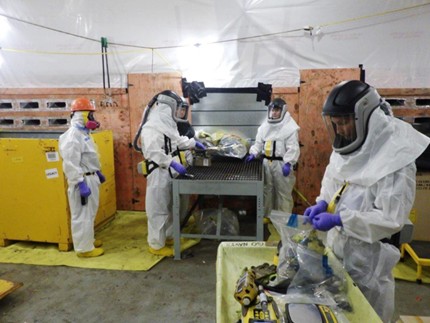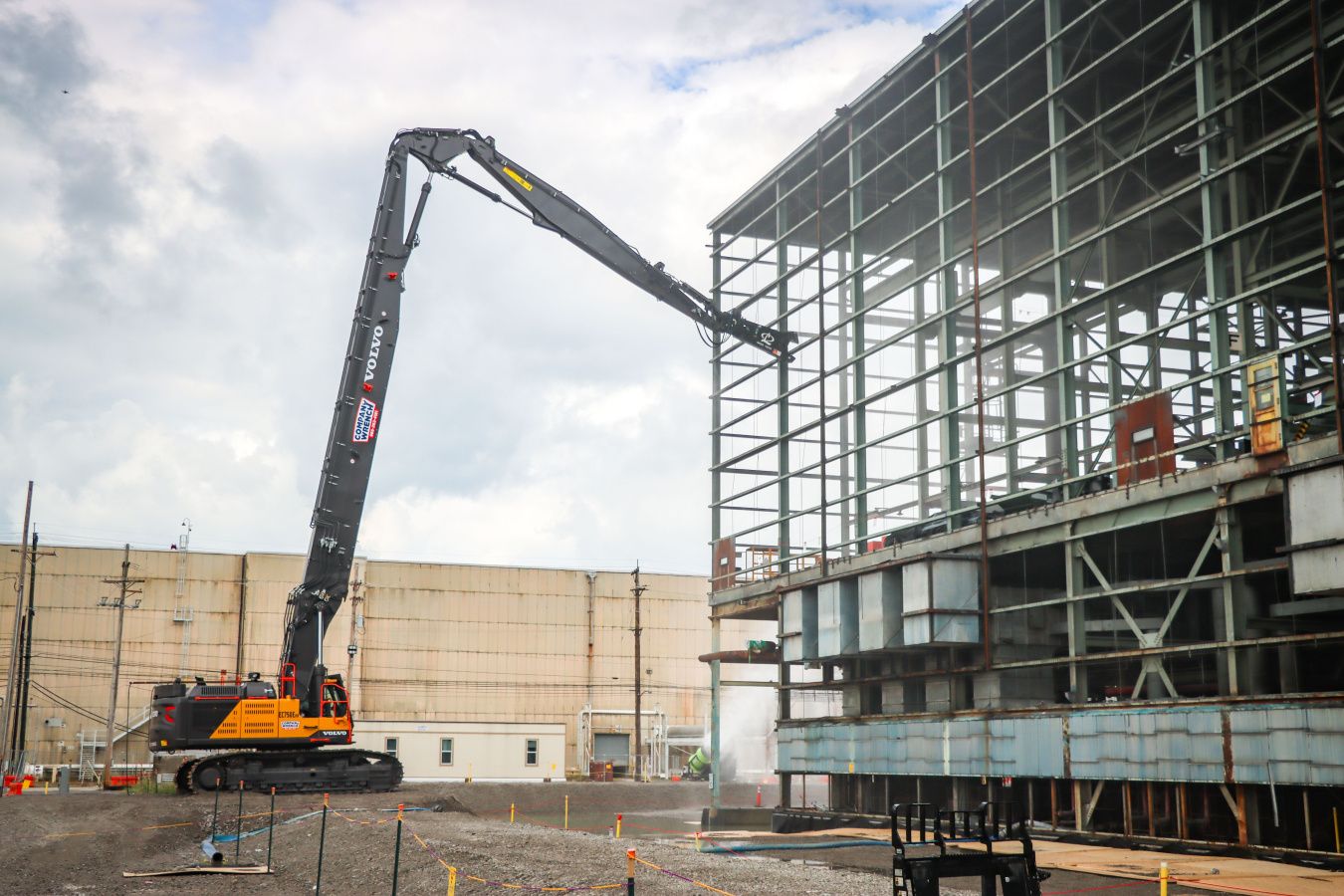SIMCO completed WIPP’s new underground ventilation system over a year early and $10 million under budget. (Photo: DOE)
The Department of Energy has issued a three-year contract extension to Salado Isolation Mining Contractors (SIMCO), a single-purpose entity comprising Bechtel National and Los Alamos Technical Associates as a teaming contractor, for the continued management and operations of the Waste Isolation Pilot Plant, the DOE’s geologic repository for defense-generated transuranic waste in southeastern New Mexico.
A WTP crew vitrified the first Hanford Site tank waste inside one of two melters in the Low-Activity Waste Facility. Top right, a camera inside the melter’s pour cave shows the vitrified waste being poured into a stainless steel container as well as the hot liquid inside the container. Bottom right, the first two containers filled with vitrified waste in the pour cave prior to being lidded, swabbed to verify their exteriors are free of contamination, and then moved into the export bay. (Photos: DOE)
The Department of Energy has announced that the Hanford Site’s Waste Treatment and Immobilization Plant (WTP) has reached a commissioning milestone, producing more than 20 stainless steel containers of immobilized low-activity radioactive waste.
Diagram of the Cigéo repository in France. (Image: Andra)
France’s Nuclear Safety and Radiation Protection Authority (ASNR) completed its technical review and issued a satisfactory opinion on Andra’s license application to construct the Cigéo deep geological disposal facility. Andra is the French national agency responsible for the safe management of all radioactive waste in the country.
A 3D-printed tool (left) that retrieves samples from radioactive waste tanks at the Savannah River Site. Also pictured are 3D-printed crawler transport baskets used during the job. (Photo: DOE)
A 3D-printed tool has been developed at the Department of Energy’s Savannah River Site in South Carolina that can eliminate months from the job of radioactive tank waste sampling.
Members of the UPWARDS technical advisory committee stand in front of a prototype universal canister system in 2024. (Photo: Deep Isolation)
Nuclear waste disposal technology company Deep Isolation Nuclear has announced the completion of a three-year project to manufacture, physically test, and validate a disposal-ready universal canister system (UCS) for spent nuclear fuel and high-level radioactive waste from advanced reactors.
Workers sort through legacy items inside the Alpha-4 building to prepare for the facility’s deactivation at Oak Ridge’s Y-12 National Security Complex. (Photo: DOE)
The Department of Energy’s Office of Environmental Management said it was insight and a questioning attitude from a project manager that led the Oak Ridge Office of Environmental Management (OREM) to accelerate the demolition of the Alpha-4 building at Oak Ridge’s Y-12 National Security Complex, helping avoid millions of dollars in costs to taxpayers.
The Paducah Site in Kentucky. (Photo: DOE)
The Department of Energy’s Portsmouth Paducah Project Office is weighing options on reprocessing approximately 9,700 tons of contaminated nickel being stored at the former Paducah Gaseous Diffusion Plant in Kentucky.
Portsmouth Site workers have taken the “first bite” of the massive X-333 Process Building, signaling the start of demolition of the massive gaseous diffusion plant building. (Photo: DOE)
Workers have begun demolishing the massive X-333 Process Building at the Portsmouth Site in Ohio, the Department of Energy’s Office of Environmental Management announced. The largest of three former uranium enrichment process buildings at Portsmouth, the X-333 building is the second of the three buildings to be demolished at the site and is a priority for DOE-EM.
The St. Lucie ISFSI with Holtec’s HI-STORM casks installed in the foreground. (Photo: Holtec)
Holtec International has completed a spent nuclear fuel dry storage campaign at NextEra Energy’s St. Lucie nuclear power plant in record time, according to the company. Twelve of Holtec's HI-STORM FW cask systems were loaded to the plant’s independent spent fuel storage installation (ISFSI) in little over one month. In total, 144 spent fuel assemblies were moved from St. Lucie’s used fuel pools to the ISFSI pad.
Members of the mentor-protégé partnership team pose for the camera. (Photo: CPCCo)
California-based Advetage Solutions has been awarded a mentor-protégé agreement with Central Plateau Cleanup Company (CPCCo), the maintenance and operations contractor for cleanup activities at the Department of Energy’s Hanford Site in Washington state.
EDF Energy’s Hinkley Point B nuclear power plant, in Somerset, England. (Photo: EDF Energy)
The U.K. government’s Office for Nuclear Regulation has granted EDF Energy formal consent to decommission the Hinkley Point B nuclear power plant in Somerset, England. The two-unit advanced gas-cooled reactor was permanently shut down in August 2022, and site owner EDF applied to ONR for decommissioning consent in August 2024.
The Sellafield site in the U.K. (Photo: Sellafield Ltd.)
Sellafield Ltd., the site license company overseeing the decommissioning of the United Kingdom’s Sellafield nuclear site in Cumbria, England, has awarded a 15-year framework contract worth up to £4.6 billion ($6 billion) to support “high hazard risk reduction programs” at the site.
SDU 10, the fifth megavolume Saltstone Disposal Unit at SRS, is the target of an upcoming leak-tightness test. (Photo DOE)
The Savannah River Site in South Carolina will begin a leak-tightness test to qualify the megavolume Saltstone Disposal Unit (SDU) 10 to store up to 33 million gallons of solidified, decontaminated salt solution produced at the site.
From left, Gerald Nieder-Westermann, IAEA waste disposal specialist; Andrea Pigorini, ITA president; Karina Lange, IAEA waste disposal specialist and scientific secretary for the IAEA’s Underground Research Facilities Network, Daniel Garbutt, ITA representative; Helen Roth, ITA executive director; Arnold Dix, ITA past president and chair of the ITA special interest group; and Stefan Joerg Mayer, IAEA team lead. (Photo: ITA)
The International Tunnelling and Underground Space Association (ITA), a nongovernmental organization made up of 81 member states working to advance the safe, beneficial use of subsurface spaces, is working with the International Atomic Energy Agency to support the advancement of geologic disposal facilities for high-level radioactive waste.
Hanford’s WTP crew celebrate the first vitrification of radioactive waste in the plant’s Low-Activity Waste Facility. (Photo: Bechtel)
The Department of Energy’s Office of Environmental Management and its contractor Bechtel announced on October 15 the start of nuclear vitrification operations at the Waste Treatment and Immobilization Plant (WTP), also known as the Vit Plant, at the Hanford Site in Washington state.

















